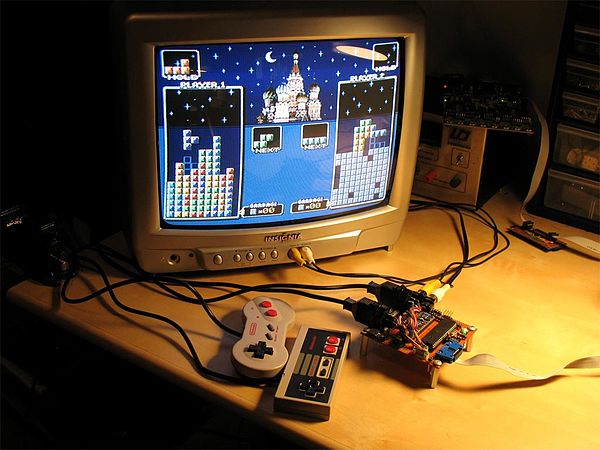History of video games/Platforms/UzeBox
-
A UzeBox console in operation in 2008, playing a falling block game.
Introduction
[edit | edit source]As a result of it's minimalist design, Uzebox became the perhaps the first open hardware game console to see significant production and development, proving a model that many other open source consoles would follow in.
History
[edit | edit source]Uzebox 1.0 was released on August 24th, 2008.[1]
Adafruit produced a Uzebox variant called the Fuzebox in November of 2008.[2]
In late 2009 video playback support was added to the Uzebox.[3]
In March of 2011 the energy drink company Redbull created a console based on the UzeBox.[4][5]
The Belogic domain which hosted the UzeBox website appears to have gone offline around January 26th, 2021.[6][7]
Technology
[edit | edit source]The technology direction of the Uzebox is described as "Retro Minimalist" by Uzebox creator Alec Bourque.[8] As a result the Uzebox uses far fewer components and uses much older technology compared to other contemporary consoles.
Compute
[edit | edit source]The Uzebox is based around an 8-bit Atmel ATmega644 AVR architecture microcontroller that is rated for 20 megahertz, but overclocked to 28.6 megahertz.[9] The ATmega644 has four kilobytes of RAM and 644 kilobytes of flash storage, which is the entirety of memory and storage on the console.[9] The Microcontroller is responsible for general compute, graphics, and sound,[9] which is especially impressive given the lack of an built in hardware GPU or audio codec on the chip. The system can generate up to 32 sprites can be displayed at once,[10] and output at a maximum resolution of 360 by 244 pixels.[10]
The microcontroller is the primary integrated circuit on the console. The only other integrated circuit used is either an AD725 or an AD723 chip depending on the configuration, which converts RGB from the microcontroller into an NTSC signal.[11]
A simple but effective DAC is implemented in resistors, with a mini DAC for Red, Green, and Blue each.[9][11] This allows the system to output up to 256 colors, with 3 bits of green, 3 bits of red, and 2 bits of blue.[10]
For sound the UzeBox has three wavetable channels, one noise channel, and one PCM channel that outputs in 8 bit mono at 15 kilohertz.[10]
The console originally adopted controllers from the NES, but were later replaced with easier to find SNES controllers.[9] Support for an SD card reader and ethernet support eventually added to the console.[9]
Games
[edit | edit source]A number of UzeBox games and demos exist.[12]
- ESD Attack - A game developed by Sparkfun Electronics.[13]
Gallery
[edit | edit source]Read more
[edit | edit source]The WikiBook Embedded Systems has a section on programing Atmel AVR processors.
References
[edit | edit source]- ↑ "replaced trunk with code from beta5 branch · Uzebox/uzebox@f38cac4". GitHub. Retrieved 10 November 2020.
- ↑ "Fuzebox, Open Source Gaming". Hackaday. 25 November 2008. Retrieved 10 November 2020.
- ↑ "Uzebox Video Player". Hackaday. 10 September 2009. Retrieved 10 November 2020.
- ↑ "Redbull Sends Marketing Doodad To Hackerspace Using An Open Source Product". Hackaday. 24 March 2011. Retrieved 10 November 2020.
- ↑ "RedBull Demo - Uzebox Wiki". uzebox.org. Retrieved 10 November 2020.
- ↑ "BeLogic Software". web.archive.org. 24 January 2019. Retrieved 2 February 2021.
- ↑ "WHOIS search results". www.godaddy.com. Retrieved 2 February 2021.
- ↑ "Achievement unlocked: Four open consoles for homebrew gamers" (in en). Opensource.com. https://opensource.com/life/11/7/achievement-unlocked.
- ↑ a b c d e f "Uzebox - The ATMega Game Console". belogic.com. Retrieved 10 November 2020.
- ↑ a b c d "Uzebox/uzebox". Uzebox. 1 November 2020. Retrieved 10 November 2020.
- ↑ a b "Uzebox - The ATMega Game Console". belogic.com. Retrieved 10 November 2020.
- ↑ "Games and Demos - Uzebox Wiki". uzebox.org. Retrieved 13 November 2020.
- ↑ "Uzebox GameCard Baseboard - DEV-09023 - SparkFun Electronics". www.sparkfun.com. Retrieved 26 March 2021.







